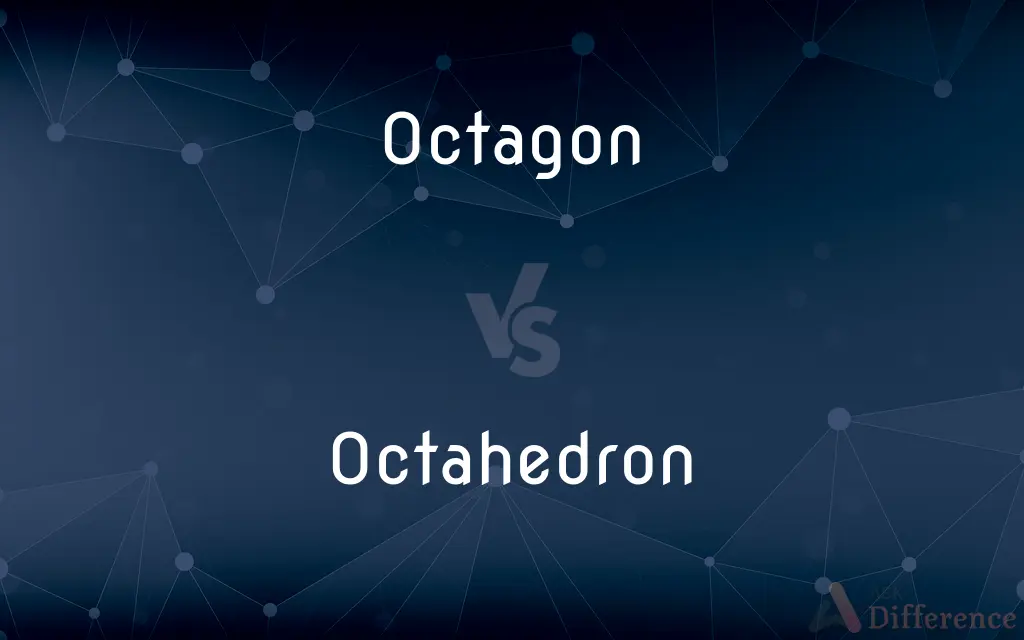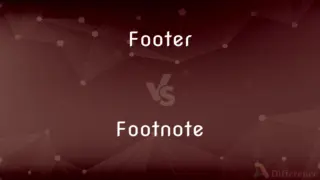Octagon vs. Octahedron — What's the Difference?
By Fiza Rafique & Urooj Arif — Updated on April 4, 2024
An octagon is a 2D shape with 8 sides, focusing on geometry, while an octahedron is a 3D figure with 8 faces, emphasizing spatial dimensions.

Difference Between Octagon and Octahedron
Table of Contents
ADVERTISEMENT
Key Differences
An octagon is a polygon with eight straight sides and angles, commonly recognized in traffic stop signs. On the other hand, an octahedron steps into the third dimension as a polyhedron, consisting of eight faces, which are typically triangular.
While an octagon lies flat on a plane, defined solely by its perimeter and internal angles, an octahedron is defined by its faces, edges, and vertices, offering a more complex structure that can be regular or irregular, depending on the lengths of its edges and the angles between its faces.
In terms of symmetry, a regular octagon features eightfold rotational symmetry and mirror symmetry along its axes, providing a sense of balance and uniformity. Whereas, a regular octahedron boasts even greater symmetry, with reflections and rotations that map it onto itself in multiple ways, showcasing the intricate beauty of three-dimensional geometry.
Regarding applications, octagons are often used in design and architecture for their aesthetic appeal and efficiency in tiling patterns. In contrast, octahedra find their place in various fields such as crystallography, where they represent the shapes of certain molecules and crystals, highlighting their importance in scientific research.
In educational settings, octagons are introduced to students as part of learning basic geometric shapes and properties, reinforcing concepts of angles and sides. Octahedra, however, are explored in more advanced mathematics and physics courses, where understanding three-dimensional shapes and spatial reasoning is crucial.
ADVERTISEMENT
Comparison Chart
Dimensions
2-dimensional (flat shape)
3-dimensional (solid shape)
Sides/Faces
8 sides
8 faces
Symmetry
8-fold rotational symmetry
Multiple axes of symmetry
Applications
Traffic signs, design, architecture
Crystallography, geometric models, art
Educational Level
Basic geometry
Advanced mathematics and physics
Compare with Definitions
Octagon
A figure used in tiling and design due to its aesthetic appeal.
The octagon tiles fit perfectly together on the floor.
Octahedron
A polyhedron with eight faces, usually triangular.
The crystal resembles a perfect octahedron.
Octagon
A fundamental concept in basic geometry.
Learning about the octagon helps students understand angles and sides.
Octahedron
A subject of study in advanced spatial reasoning.
Understanding an octahedron's geometry requires knowledge of three-dimensional shapes.
Octagon
A shape that can be regular (all sides and angles equal) or irregular.
We cut out a regular octagon for our geometry project.
Octahedron
Used to describe the structure of certain crystals and molecules.
Diamonds sometimes crystallize in an octahedral structure.
Octagon
A symbol of balance and uniformity in shapes.
The octagon represents equilibrium in certain cultural designs.
Octahedron
A shape that can manifest in both regular and irregular forms.
This model shows a regular octahedron with all faces equilateral triangles.
Octagon
In geometry, an octagon (from the Greek ὀκτάγωνον oktágōnon, "eight angles") is an eight-sided polygon or 8-gon. A regular octagon has Schläfli symbol {8} and can also be constructed as a quasiregular truncated square, t{4}, which alternates two types of edges.
Octahedron
Represents complexity and symmetry in three dimensions.
The octahedron is admired for its symmetrical properties.
Octagon
A plane figure with eight straight sides and eight angles.
Octahedron
In geometry, an octahedron (plural: octahedra, octahedrons) is a polyhedron with eight faces, twelve edges, and six vertices. The term is most commonly used to refer to the regular octahedron, a Platonic solid composed of eight equilateral triangles, four of which meet at each vertex.
Octagon
A polygon with eight sides and eight angles.
Octahedron
A polyhedron with eight faces.
Octagon
A polygon with eight sides and eight angles.
Octahedron
(geometry) a polyhedron with eight faces; the regular octahedron has regular triangles as faces and is one of the Platonic solids.
Octagon
(martial arts) Often in the form Octagon: the arena for mixed martial arts.
Octahedron
A solid bounded by eight faces. The regular octahedron is contained by eight equal equilateral triangles.
Octagon
A plane figure of eight sides and eight angles.
Octahedron
Any polyhedron having eight plane faces
Octagon
Any structure (as a fortification) or place with eight sides or angles.
Octagon
An eight-sided polygon
Common Curiosities
What is a common use of an octagon in everyday life?
A common use is the stop sign, which is shaped as a regular octagon.
Can an octagon be three-dimensional?
No, an octagon is strictly a two-dimensional shape, defined by its sides and angles on a flat plane.
Can an octagon have curved sides?
No, by definition, an octagon consists of straight sides.
What educational level is appropriate for learning about octahedra?
Octahedra are generally introduced in advanced mathematics and physics courses.
What makes an octagon different from an octahedron?
An octagon is a two-dimensional shape with eight sides, while an octahedron is a three-dimensional figure with eight faces.
How many edges does an octahedron have?
A regular octahedron has 12 edges.
Are all octahedra regular?
No, octahedra can be regular (with all faces being equilateral triangles) or irregular.
What role do octahedra play in geometric models?
They are used to understand spatial relationships and structures in three dimensions.
How is an octahedron used in crystallography?
It models the shapes of certain crystals and molecules.
Are octagons and octahedra related in any way?
While both have eight as a base numerical value (sides for octagon, faces for octahedron), they differ in dimensions and complexity.
Is it easier to construct an octagon or an octahedron?
Constructing a two-dimensional octagon is generally simpler than constructing a three-dimensional octahedron, which requires more complex spatial reasoning.
What symmetry does a regular octagon have?
A regular octagon has eightfold rotational symmetry and mirror symmetry.
Do all octahedra have triangular faces?
Yes, a typical characteristic of an octahedron is its triangular faces, especially in regular octahedra.
Can octagons tile a plane without gaps?
Yes, octagons can tile a plane, especially when combined with other shapes like squares.
Share Your Discovery

Previous Comparison
Footer vs. Footnote
Next Comparison
Truly vs. TruthfullyAuthor Spotlight
Written by
Fiza RafiqueFiza Rafique is a skilled content writer at AskDifference.com, where she meticulously refines and enhances written pieces. Drawing from her vast editorial expertise, Fiza ensures clarity, accuracy, and precision in every article. Passionate about language, she continually seeks to elevate the quality of content for readers worldwide.
Co-written by
Urooj ArifUrooj is a skilled content writer at Ask Difference, known for her exceptional ability to simplify complex topics into engaging and informative content. With a passion for research and a flair for clear, concise writing, she consistently delivers articles that resonate with our diverse audience.
















































